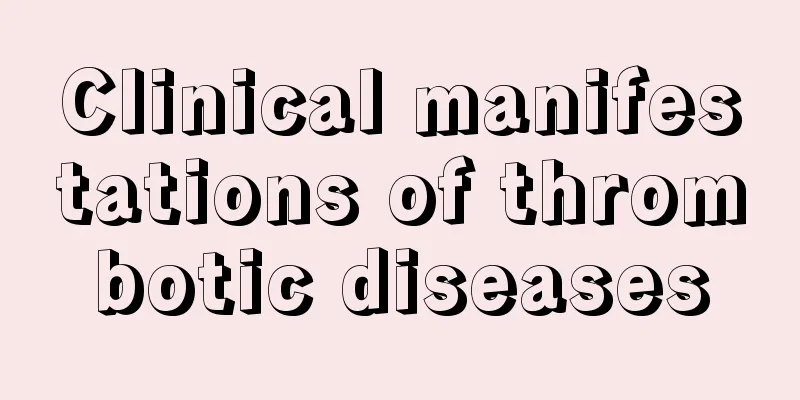Clinical manifestations of thrombotic diseases

|
In our daily lives, many people are always busy with work and life, which leads to insufficient time for exercise and long-term irregular living habits. This is particularly prone to the occurrence of thrombotic diseases, which will cause great harm to our bodies. In order to be able to detect the disease in time and get the most effective treatment, we must master more symptoms of the disease. Let’s learn about the clinical manifestations of thrombotic diseases. Clinical manifestations of thrombotic disorders 1. Venous thrombosis Deep vein thrombosis of the lower extremities is the most common It is common in deep veins such as the popliteal vein, femoral vein, mesenteric vein and portal vein. Most of them are red blood cell thrombi or fibrin thrombi. The main manifestations are: ① Local swelling and pain caused by thrombosis; ② Distal blood reflux disorder of thrombus: such as distal edema, distending pain, skin color change, ascites, etc.; ③ After the thrombus breaks off, it embolizes the blood vessels and causes dysfunction of related organs, such as symptoms and signs of pulmonary infarction. 2. Arterial thrombosis is common in coronary arteries, cerebral arteries, mesenteric arteries and limb arteries. The early types of thrombosis are mostly platelet thrombosis, followed by fibrin thrombosis. Clinical manifestations include: ① The onset is usually sudden, with severe local pain, such as angina pectoris, abdominal pain, severe limb pain, etc.; ② Organ, tissue structure and function abnormalities caused by ischemia and hypoxia in the relevant blood supply parts, such as myocardial infarction, heart failure, cardiogenic shock, arrhythmia, impaired consciousness and hemiplegia; ③ Thrombus detachment causes symptoms and signs such as cerebral embolism, renal embolism, and splenic embolism; ④Clinical manifestations caused by ischemic necrosis of blood supply tissue, such as fever. 3. Capillary thrombosis is common in DIC, TTP, and hemolytic uremic syndrome (HUS). The clinical manifestations are often non-specific and mainly include embolic necrosis of the skin and mucous membranes, microcirculatory failure, and organ dysfunction. The following is an introduction to the clinical manifestations of thrombotic diseases. After understanding it, we know that its symptoms are generally different depending on the site of onset, and the symptoms caused are also different. Therefore, we must maintain good living habits, go to bed early and get up early, and try to eat more light foods and do more outdoor sports. This can effectively avoid the occurrence of some diseases. |
<<: What should we pay attention to in the rehabilitation training of triple ankle fracture
>>: Analysis of normal values of 24-hour urine protein quantitative
Recommend
Only with the prevention method of colorectal cancer can people live a healthy life
Nowadays, the incidence of colorectal cancer is v...
What are the complications caused by lymphoma
Lymphoma is a malignant tumor originating from th...
The importance of confidence
Confidence is a manifestation of human psychology...
A layer of white stuff grows on the scalp
If there is white stuff on the scalp, it is likel...
Can I use gasoline to clean the range hood?
Many people will use some very special methods to...
The benefits of tapping your lungs every day
The roles played by the heart and lungs in the hu...
What is aortic valve calcification and regurgitation?
Aortic valve calcification and regurgitation are ...
What are the symptoms of colorectal cancer and how to diagnose it?
In addition to early colorectal cancer, which may...
Can you still eat expired nuts?
Whether expired nuts can be eaten should be judge...
Good habit of detoxifying before going to bed, beautifying and nourishing the skin, definitely save it!
Doing something beneficial to weight loss before ...
What causes back pain? Be careful of this disease
Many people often feel severe back pain in normal...
Tips for itchy nose
Itching inside the nose is very common in life. W...
What is the reason for the itchy red spots on the instep
There are many things in life that need our atten...
How to get rid of the monkey on the arm
Many people often have monkeys on their arms. Thi...
What to eat to prevent lung cancer? Eat these foods regularly to stay away from lung cancer
Nowadays, people's living environment and lif...









